Types of Lake Ice
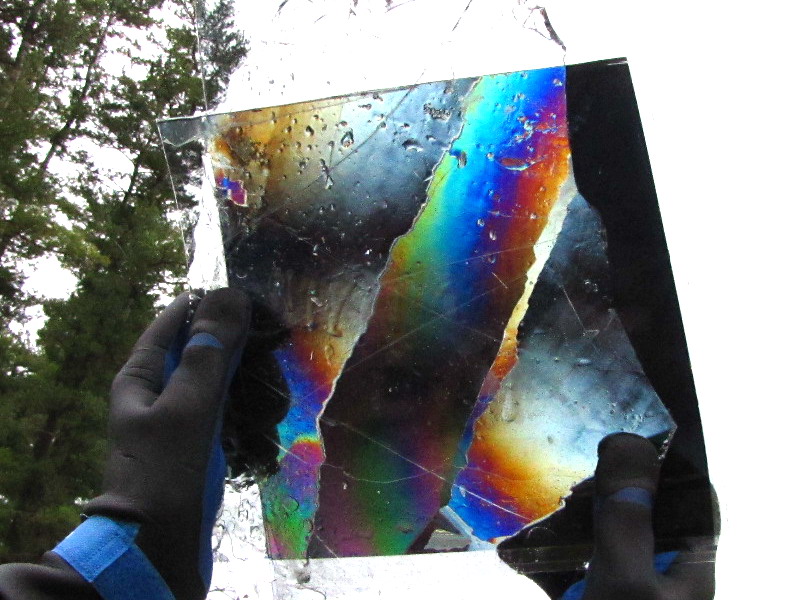 One cm thick P1 ice as seen between crossed polarized sheets.
One cm thick P1 ice as seen between crossed polarized sheets.
Lake ice is crystalline and comes in a few crystal arrangements. Various classification systems have been developed to describe them. The following describes two of widely used systems. The first is a simple and practical classification from Tony Gow. For most purposes this is sufficient.
- Unseeded ice: large crystals with a vertical C axis (aka: type S1 ice, tabular ice, or large grain ice). Unseeded ice occurs when the metrological conditions have no snow or ice fog falling onto the water surface to seed it and winds are light allowing large crystals to form on the surface with out being broken up by waves. The air temperature is above 20(?) deg F.
- Seeded ice: smaller crystals with a more horizontal C axis (aka: S2 ice, small grain ice or columnar ice). When many ice particles are available on the water surface the the ice that forms has a large number of small crystals. The ice particles can come from snow falling into the water, ice fog particles, dendritic crystals broken by wave action and frazil turbulence from beaking waves. The primary ice has crystals roughly 0.02" to one inch in diameter (see picture below). Cold, windy conditions tend to form seeded ice. The ice that forms underneath the primary ice layer start small and get bigger with depth as crystals with a more vertical C axis edge out those with a more horizontal one.
- Snow ice: frozen slush that forms on top of the ice sheet. (Type T1 ice), Snow ice forms on top of the ice sheet and does not affect ice that forms on the bottom of the ice sheet. It usually melts off the underlying after a significant thaw. In the case of shallow ponds sometimes the underlying black ice melts first.
The following is a more detailed system that is helpful for more technical understanding
In 1971 a lake and river ice classification system was established by Bernard Michel and R Ramseier (ref 1,2)
- Primary Ice: The first ice that forms
- Secondary Ice: Ice that forms under primary ice
- Superimposed Ice: Typically snow ice and puddle ice on top of the ice sheet or frazil ice underneath.
- Agglomerate Ice: broken ice that refreezes into an ice sheet.
Primary Ice is first thin layer to form. It sets the stage for the ice that forms on the bottom of that layer as the ice thickens. The primary ice layer on a new and thickening ice sheet often melts or sublimes in an early thaw.
- P1 ice forms in calm conditions at temperatures moderately below freezing. The crystal size is large to extra large. It is called 'large grain ice' elsewhere on the Lakeice site. The C axes of most of the crystals are near vertical.
-
 6" long needle that was growing across the thin supercooled layer of a puddle around sunset. Dendtiric growth is starting, especially on the lower side (sawtooth pattern).Some Detail: P1 ice starts as needles growing across a thin, moderately supercooled layer on the surface of the water. They grow until they run into each other. After that, dendritic growth fills in the space between the needles. The needles grow rapidly on one of the three 'rough' A axis that grow quickly in supercooled water (this is called 'fast growth'). The C axis of of the needles is perpendicular to the to the plane of the three axes and it can point in any direction. The branched dendritic growth that fills in the unfrozen areas between the needles typically grows on all three axes and and is confined to the thin supercooled surface layer. This means that the C axis is very close to vertical (often within a small fraction of a degree). See the next picture.
6" long needle that was growing across the thin supercooled layer of a puddle around sunset. Dendtiric growth is starting, especially on the lower side (sawtooth pattern).Some Detail: P1 ice starts as needles growing across a thin, moderately supercooled layer on the surface of the water. They grow until they run into each other. After that, dendritic growth fills in the space between the needles. The needles grow rapidly on one of the three 'rough' A axis that grow quickly in supercooled water (this is called 'fast growth'). The C axis of of the needles is perpendicular to the to the plane of the three axes and it can point in any direction. The branched dendritic growth that fills in the unfrozen areas between the needles typically grows on all three axes and and is confined to the thin supercooled surface layer. This means that the C axis is very close to vertical (often within a small fraction of a degree). See the next picture.
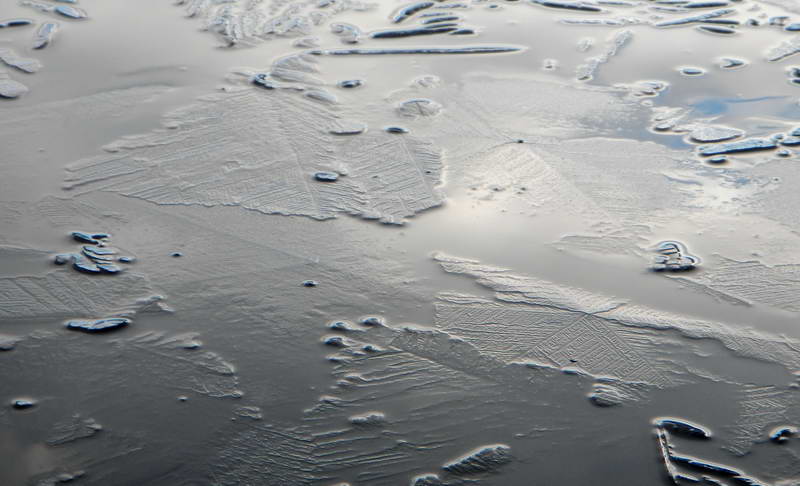 P1 ice about 1 mm thick. Christmas tree like dendritic growth (analogous to a single arm of a dendritic snowflake)). Scale: 'trees' about 10" across
P1 ice about 1 mm thick. Christmas tree like dendritic growth (analogous to a single arm of a dendritic snowflake)). Scale: 'trees' about 10" across
- P2 ice also forms in calm conditions but with colder temperature conditions. It is similar to P1 ice except with more crystals that have a randomly oriented C axis. The crystal sizes are large to very large.
- P3 ice is seeded (nucleated) by frazil that forms in turbulent conditions in rivers and windy lakes and in wavy conditions on lakes. The crystal size is fine to medium and their C axes are randomly oriented. This form of ice is very common on rivers where their flow related turbulence favors formation of frazil. In my opinion there ought to be a P3R and P3L types as river frazil has a significantly different formation mechanism than lake frazil.
- P4 ice is seeded by snow falling on calm water or wavy water. The crystal size is similar to P3 (fine to medium) and the C axis direction is random.
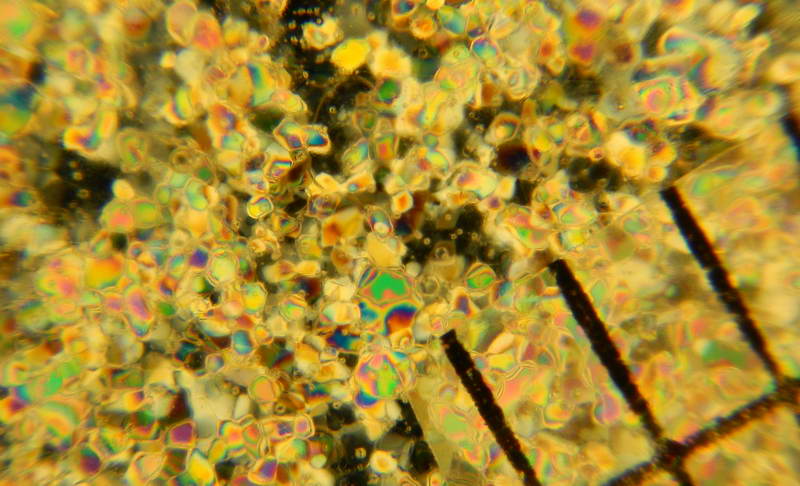 Close up of P4 Ice- snow ice - between crossed polar filters- about 2 mm thick-air bubbles visible in dark grains (C axis vertical). Scale increments = 0.1"
Close up of P4 Ice- snow ice - between crossed polar filters- about 2 mm thick-air bubbles visible in dark grains (C axis vertical). Scale increments = 0.1"
Note: even moderate amounts of wind on a lake can break up the A axis needles and dendritic growth that would otherwise become P1 or P2 ice. The broken up pieces become 'spicule lake frazil'. The pieces are blown down wind, accumulating in rafts or on the upwind side of existing ice or on lee shore or the pond or lake. These small broken pieces lead to a finer grained ice similar to P3 and P4 even though snow or discoid frazil is not present. Like all primary ice, it sets the grain size and orientation for the underlying secondary ice. It may account for much of the ice with grain sizes between P1-P2 and P3-P4.
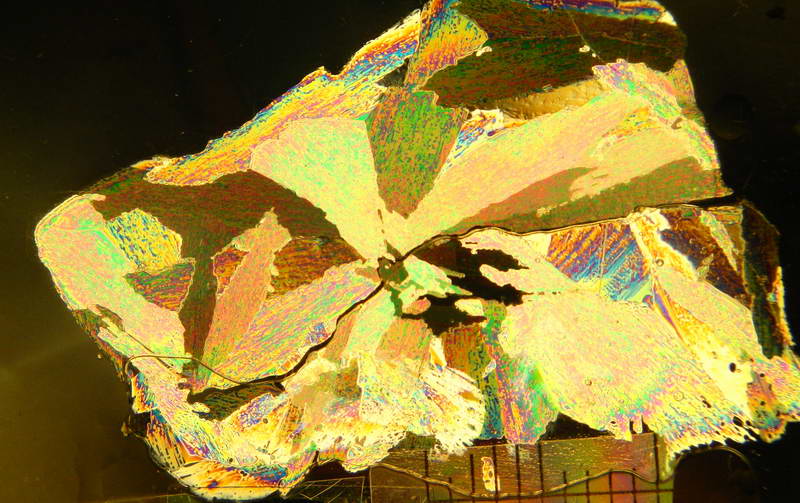 An example of wind/wave broken P1 ice (shown before breaking up in the P1 dendrite picture above). It has significantly smaller grain size primary ice layer and the C axis orientation mostly not vertical. Scale increments: 0.1". Picture between crossed polars.
An example of wind/wave broken P1 ice (shown before breaking up in the P1 dendrite picture above). It has significantly smaller grain size primary ice layer and the C axis orientation mostly not vertical. Scale increments: 0.1". Picture between crossed polars.
Secondary Ice either forms under or on the primary ice. Often it is ice that grows (congeals) onto the bottom surface of the existing ice sheet. This type of growth is referred to 'slow growth' as there is minimal supercolling involved It can also be snow slush or frozen puddles on top of the ice sheet or frazil slush that accumulates on the bottom near a river or stream inlet.
- S1 ice is congregation ice that normally forms on the bottom of P1 and P2 ice. The crystals are extensions of the original primary ice crystals. The C axis is vertical.
- S2 ice forms under fine grained P3 and P4 ice and sometimes under P2. As seen in the following picture it starts with vertical crystals about the same size as the primary ice. These get bigger with depth. The crystal axes are near horizontal at the bottom of the primary ice and become mostly vertical by 5-20 cm depth as the faster A axis growth laterally pinches off the slower C axis growth of less favorably oriented crystals. S2 is classic 'small grain' ice.
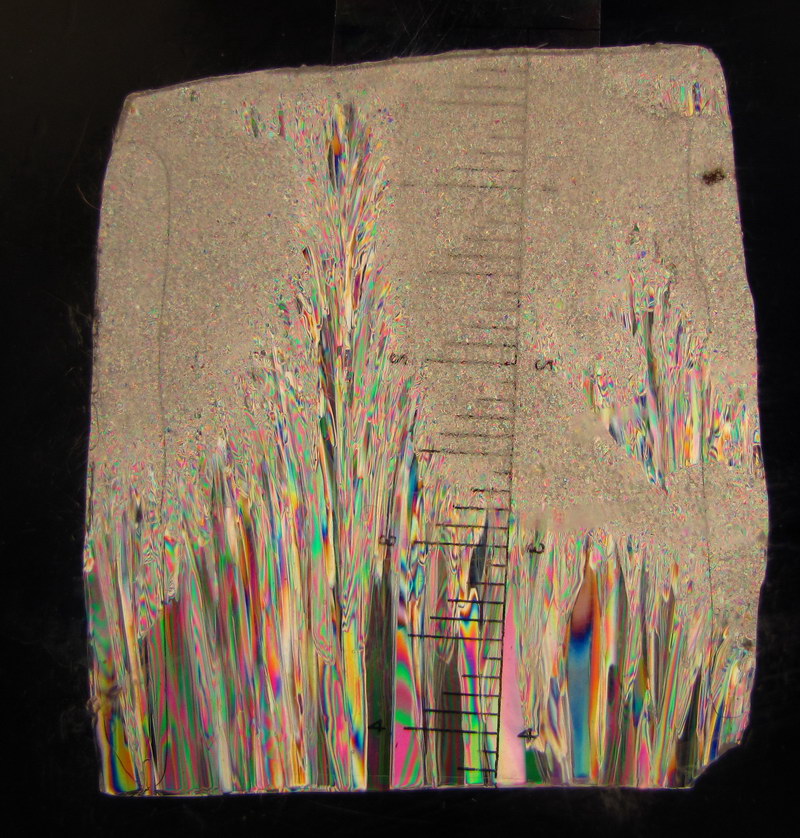 A vertical slice of S2 ice growing off primary slush ice (P3L), scale: small increments = 1/10th "
A vertical slice of S2 ice growing off primary slush ice (P3L), scale: small increments = 1/10th "
- S3 ice has an aligned, horizontal C axis. It is found at the bottom of some very thick ice sheets and is probably not relevant to ice we are likely to be on.
- S4 ice is congealed frazil ice that becomes some or all of an ice sheet. Frazil forms in suspension in turbulent water and then builds up on the bottom of the ice cover. S4 ice is mostly found on rivers and it can form in lakes near river inlets.
- A variation on S4 ice is common on lakes that catch in wavy conditions. The ice forms as mostly dendritic crystals (needle frazil and flake ice) in a thin surface layer of supercooled water. These get blown down wind and accumulate at lee shores and ice edges. There the crystals and crystal rafts are broken into a relatively fine slush that can accumulate to depths of a foot or more. Often shoreline ice is largely made up of this ice type as shown in the picture below. more
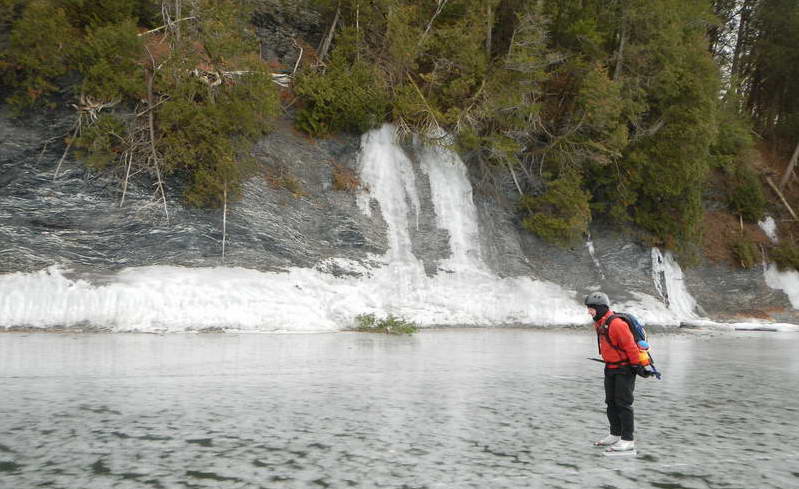 Slightly seporated slush balls (S4) on a lee (down wind) shore of Outer Mallets Bay on Lake Champlain. The dark ice is S2 (small grain) black ice.
Slightly seporated slush balls (S4) on a lee (down wind) shore of Outer Mallets Bay on Lake Champlain. The dark ice is S2 (small grain) black ice.
Superimposed Ice
- T1 ice is snow ice that is almost always formed when snow falls on an ice sheet and is saturated by water by submerging the ice sheet (either from the weight of snow or wicking water through cracks), from rain after the snow fell or partial thawing of the snow cover.
- T2 ice is drained snow ice occurs when slush is drained rapidly by a falling water level or a rising ice sheet level (can be caused by local buckling of an ice sheet under compression). It has a density about 2/3rds of black ice.
- T3 ice is surface ice that typically forms on puddles created by melt water, rain or moderate compression buckling of the ice sheet. T3 ice is common around pressure ridges of all types for this reason. Shell ice is T3 ice.
Agglomerate Ice: This is very common at any lee (downwind) shore or ice edge where the edge of the ice sheet is broken by waves and where broken ice pieces drift down wind and accumulate at an ice edge. Often the pieces get rotated into vertical stacks. It is especially common on large lakes that are partially frozen for a long time.
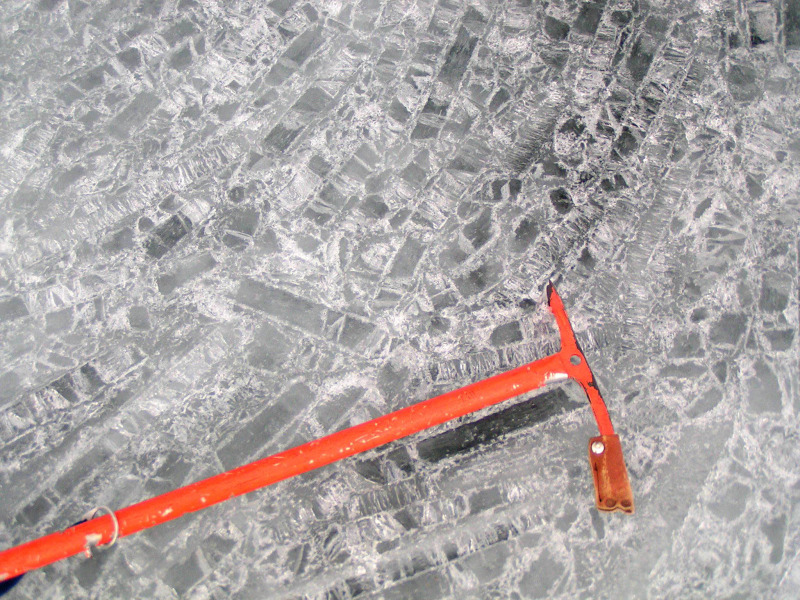 One of many types of aglomerate ice. In this case a 1.5" ice sheet was broken up by waves and stuffed together against a lee shore with the pieces tiped to vertical. The aglomerate ice surface was later zamobonied flat in a thaw.
One of many types of aglomerate ice. In this case a 1.5" ice sheet was broken up by waves and stuffed together against a lee shore with the pieces tiped to vertical. The aglomerate ice surface was later zamobonied flat in a thaw.
Phases of Ice
Many materials have different solid state phases at different temperatures and pressures. The crystal structure of the the phases are different. Ice has 17 phases, more than any other material. All the types of ice discussed above are crystalline phase 1h. 1h has a hexagonal structure. It is the only phase that is seen at temperatures and pressures that are found on lakes and rivers. Most of the other ice phases are found at low temperatures but at very high pressures (over 1,500,000 psi), ice stays solid at 700 deg F.
Click here for more information on ice phases (near the bottom of the page)
References:
Michel, B. and R. Ramseier, 1971. Classification of River and Lake Ice, Canadian Geotechnical Journal, vol. 8,no 1, pp. 35-45
George D. Ashton, River Lake Ice Engineering, Water Resources Publications, pages 27-30. This book is thought of by some as the bible of river and lake ice. It can be purchased from the publisher for $68. http://www.wrpllc.com/allbooks.html#Rs.
Tony Gow and Steve Daly (Both from CRREL) were helpful in explaining some of the details.
Notes in italics are notations added by the lakeice site editor
